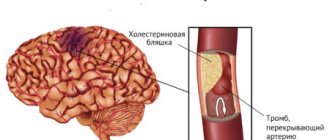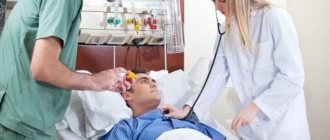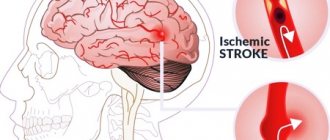A stroke is a reactive, acute disruption of the blood supply to the brain, accompanied by the rapid appearance of foci of necrosis. Depending on the time during which blood circulation is not restored to normal levels, the general prognosis of the patient’s life depends. The patient can die within hours. What a person’s life depends on, symptoms, stages, how they die from a stroke - all this is described in detail below.
Classifications of strokes
In practice, a simple classification is used, distinguishing two forms of stroke depending on the causes that gave rise to the hemorrhage: ischemic and hemorrhagic. In addition, stroke periods and severity levels are distinguished.
Ischemic stroke
Statistically, it occurs more often, up to 85% of all cases, appearing as a result of the closure of the lumens of blood vessels that supply a certain part of the brain. Closure of the vessel can occur due to a blood clot, atherosclerotic plaque, or due to narrowing of the walls due to severe spasm.
This type of stroke does not occur overnight. It develops progressively, one pathological process follows another.
- Blood flow decreases.
- There is a sharp release of glutamate and aspartate, excitotoxicity occurs (a pathological process that leads to serious damage and death of nerve cells under the influence of neurotransmitters).
- Calcium accumulates inside each cell.
- The activation of intracellular enzymes increases, the lack of oxygen progresses, and foci of local inflammation arise.
- Brain neurons die.
All stages occur with increasing cerebral edema, cells increase in volume, and intracranial pressure indicators increase. Because of this, local parts of the brain - the temporal lobes - are displaced, the midbrain is pinched, which leads to compression of the medulla oblongata (due to the entry of the cerebellum into the foramen magnum). With this development, death from a stroke is most often stated.
Hemorrhagic stroke
This form of stroke was once called “apoplexy.” Registered in 15% of cases. Formed due to a rupture of the vessel wall or an aneurysm. The cause may be a sharp jump in blood pressure or pathology in the walls of the vessels themselves. Spontaneous hemorrhage occurs in the brain tissue (in the subarachnoid space).
Hemorrhagic stroke occurs due to increased physical or emotional stress. If, after exertion, you feel severe headaches, your surroundings appear reddish, and nausea occurs, you can talk about the preconditions for a stroke.
With such a pathology that occurs in the brain stem, a person does not live more than 48 hours. He dies without regaining consciousness. External signs of death from a stroke: pale skin, sensations of approaching death, one half of the body, on the side where there was hemorrhage, is dark purple. This is one of the specific external manifestations of death from a stroke.
Periods of stroke
Cerebrovascular accident occurs over several periods.
- The most acute phase.
- Spicy.
- Early recovery period after stroke.
- Late recovery period after hemorrhage.
- Complications and consequences of hemorrhage.
- Long-term consequences.
Death most often occurs during the hyperacute and acute phases.
Severity
Depending on the size of the area of brain damage, there are three degrees of stroke severity.
- Small stroke (micro-stroke). Neurological pathologies appear, the symptoms are not expressed, they can be confused with manifestations of other fatal diseases.
- Light to medium severity. Focal symptoms can be observed; there are no signs of altered consciousness or cerebral edema.
- Severe degree. The patient is unconscious, neurological disorders progress rapidly, and severe cerebral edema occurs. This condition ends in death.
Important! Stroke is a dynamic process. The sooner the patient receives adequate, highly qualified medical care, the greater the likelihood of restoring the full range of brain functions. Hospitalization is necessary in the first three hours after detection of hemorrhage to prevent death.
Reasons that cause the death of brain cells and lead to death
The death of cells in the brain stem and cerebellum, which causes death, can develop as a result of impaired nutrition and oxygenation of cells, displacement or swelling of tissues:
- hemorrhage in the brain stem and cerebellum;
- ischemia of the deep parts of the brain;
- hemorrhage into the ventricles of the brain, causing hemotamponade of the cerebrospinal fluid outflow tracts, which leads to disruption of the circulation of cerebrospinal fluid, occlusive hydrocephalus, edema and displacement of the brain stem.
- cerebral edema can be gradually increasing or rapid, which leads to dislocation of brain structures and herniation of the brain stem in the foramen magnum.
Concomitant diseases can also cause death. Often, against the background of cerebral circulatory disorders or after it, myocardial infarction or acute conditions develop, such as failure of the cardiovascular, respiratory systems, renal or liver failure.
Statistical data
Death due to stroke and signs of the early stage of the disease are being recorded more and more often in Russia. Stroke is rapidly getting younger. Factors affecting the unfavorable environmental situation in large cities, constant stressful situations at work and at home, and abuse of alcohol and tobacco products. In world practice, stroke ranks third in the overall statistics of all deaths, in Russia it ranks second.
A higher percentage of mortality is recorded from the hemorrhagic form of cerebral hemorrhage.
| View | Mortality percentage |
| Ischemic | 12-17% |
| Intracerebral hemorrhage | 53-83% |
| Subarachnoid | 33-65% |
The gender distribution of risk, or how men and women die from stroke, is as follows:
- death from stroke in women occurs in more than 43% of cases;
- men die less often – 36.6%.
Rehabilitation and prevention play an important role, because statistically the highest percentage of mortality is recorded after a recurrent stroke.
For information. Only 59.9% of patients who apply receive qualified and timely assistance. The rest self-medicate (34%), others do not receive help at all (5.7%).
Rapid death of a patient
There have been cases of immediate death from stroke in patients with extensive hemorrhage. It affects large areas of brain tissue, with deep penetration and damage to large vessels. Violating their integrity, the blood spreads to the hemispheres, thereby affecting the vital centers. A major stroke results from micro-strokes, persistently elevated blood pressure, repeated strokes, etc. Particularly dangerous and fraught with instant death is an extensive brainstem stroke - this is a type of disease characterized by damage to the nerve bundle of the brainstem. Unfortunately, this type of stroke in 95% of cases leads to paralysis and rapid death of the patient.
To avoid the re-development of various types of stroke, patients who have already suffered it once are recommended to frequently visit a doctor and be examined, as well as sanatorium-preventive treatment, rehabilitation appointments, and taking the necessary medications. Your life – health and longevity – depends on fulfilling the doctor’s requirements and recommendations. If you have a genetic predisposition to stroke or your health status indicates that you are likely to acquire the disease, you should make every effort to prevent the formation of conditions and environments for this.
Causes of stroke
The main causes of death in stroke (risk factors) include the following human conditions:
- an increase in blood pressure is permanently recorded, which also indicates an increase in intracranial pressure;
- hereditary factor: strokes have been reported in close relatives;
- excess body weight;
- smoking and alcohol abuse;
- vegetative-vascular diseases;
- a history of aneurysm;
- sedentary lifestyle (in bedridden patients, the risk of stroke increases);
- diseases of diabetes mellitus and atherosclerosis;
- paroxysmal headaches, and very severe ones;
- periodic numbness of any part of the body or face;
- the appearance of a dark veil before the eyes, temporary loss of vision;
- attacks of unexpected weakness.
Precursors of death in stroke
Signs of a stroke usually increase before death. Even if shortly before this the patient’s condition began to improve. The most alarming symptoms include:
- very dry skin and mucous membranes;
- patient hypothermia (can be up to 25 degrees);
- the appearance of pale cadaveric spots on the lower extremities.
Causes for concern are the development of hallucinations, apathy, cold extremities, and intermittent breathing. These signs before death in a bedridden patient after a stroke should be a reason for intensive therapy or resuscitation measures. A diagnosed stroke that does not cause immediate death has every chance of being completely cured, provided adequate treatment is provided.
A bedridden patient after a stroke may show other signs before death. Thus, one can assume that death is approaching if the following symptoms begin to appear:
- periodic disturbances of consciousness;
- inability to swallow;
- sharply increased body temperature;
- impaired eye movements;
- lack of appetite;
- arterial hypertension, even if the patient had not previously been diagnosed with it;
- decreased amount of urine output.
These signs of impending death after a stroke do not mean that death is inevitable. But they serve as a clear signal to the doctor about this possibility. At this time, there is still an opportunity to adjust therapy and save the patient. The causes of death after a stroke are usually standard.
Symptoms of a stroke
Sudden focal neurological symptoms in combination with meningeal manifestations indicate the presence of an acute, severe disorder of cerebral circulation. The brain, not receiving enough oxygen and nutrients due to impaired blood supply, begins to change destructively; at first these changes are reversible, then these processes can no longer be reversed. That is why every person should know the signs of the disease and what death from a stroke looks like in order to provide timely help to a loved one or passerby. These symptoms include:
- an attack of severe headache or dizziness;
- paralysis of a part of the face or body, expressed in slurred speech, inability to control one’s movements, and impaired fine motor skills;
- loss of consciousness;
- various types of paresis;
- sudden complete or partial loss of vision;
- severe excess of normal pressure indicators;
- open vomiting and nausea;
- problems with the perception of surrounding reality;
- involuntary bowel movements or urination.
Important! If you suspect a stroke, you need to ask the person to smile, raise their hands up and say a simple phrase. If one of the corners of the mouth “slides” down, forming a crooked smile, the tongue “twists” during speech, and you cannot raise your hands, then urgent professional help is needed. In this situation, delay is like death.
A diagnosis can only be made by carefully studying the general clinical picture, medical history, risk factors, and neurological symptoms.
Causes of death from strokes
In most cases, death after a stroke in the elderly occurs while still in a medical institution. The main cause is the death of GM neurons. As a result, the brain stops performing its function. There are several reasons for this:
- the process developed in the cerebellum and made its work impossible;
- hemorrhagic process in the brain stem;
- pathological process in the ventricles of the brain.
In addition, the statistics of deaths from stroke indicate that against the background of such a lesion, other serious pathologies can develop. Sudden death from stroke occurs during the most acute period of the disease, and is associated with severe swelling of the brain and progressive neurological disorders.
Attention! Sudden death is most likely if the patient has another attack within one calendar year.
External signs of death from stroke
It is possible to determine that a person who has suffered a stroke is close to the end by external signs that indicate irreversible processes in the brain. Harbingers of approaching death are:
- disturbance of consciousness;
- unsteady gait, sweeping movements;
- the patient cannot speak, move, open or close his eyes;
- swallowing reflex is absent;
- there is inadequate motor activity, convulsions, twitching of the arms and legs, more like convulsions;
- increased body temperature - more than 40 degrees (indicates damage to neurons that regulate thermodynamics);
- eye movements are disturbed - by lifting the eyelid, you can see that the eyes seem to “float”, the pupil on the side of the hemorrhage is greatly dilated;
- high blood pressure, increased heart rate, bradycardia;
- appetite is reduced, stool is scanty and harder;
- urine is more concentrated and its quantity decreases;
- deep noisy breathing (Kussmauel breathing type), there are long pauses between inhalation and exhalation;
- breathing is sometimes deep, sometimes shallow.
Signs of dying in a bedridden patient after a stroke
Before death, a bedridden patient feels a loss of strength and fatigue. As a result, the patient sleeps constantly. Sleep can be deep or light (with light sleep, voices and various other sounds are heard).
Before death, one feels and sees something that is not really there. Orientation in space is often lost and consciousness becomes confused. The patient becomes withdrawn and loses interest in everything that is happening.
The urine turns red due to poor kidney function, which also causes swelling. A bedridden patient breathes quickly and unstably. Due to poor blood circulation, venous spots appear. Initially they appear on the legs. Before death, the patient's limbs become cold as blood rushes to vital organs. All these are the main signs of approaching death.
Signs of a patient dying from a stroke appear on average after 15 minutes. Signs of death:
- the person does not respond and does not react to ammonia, as well as to blows on the cheeks;
- pupils do not react to light;
- the pupils become oval when squeezed from the sides;
- no pulse or breathing;
- the cornea of the eye becomes cloudy.
Signs of death during the first day:
- dry mucous membranes and skin;
- rigor mortis appears;
- the appearance of cadaveric spots;
- decrease in body temperature down to 25 ° C (in the rectum).
Doctors are confident that the risk of death can only be reduced by adhering to preventive measures. If you eat right, avoid bad habits, and check your health, you can avoid the risk of stroke. If a doctor notices early signs of a stroke that threaten the health of patients, then it is necessary to follow all the recommendations of doctors in order to never experience the full severity of this disease.
What does clinical death from a stroke look like?
If the ischemic process progresses, the prognosis will be unfavorable. There are three main signs (conditions) by which clinical death is determined. The first 4 minutes are decisive. After establishing the symptoms of clinical death, resuscitation measures are taken. If they are unsuccessful, the onset of biological death is recorded.
Additionally, the table shows what death from a stroke looks like.
| State | Short description |
| Coma |
|
| Apnea | Complete absence of respiratory activity, no respiratory movements of the chest. |
| Asystole |
|
Death after acute hemorrhage in the brain area can be caused by various reasons (from pulmonary edema to cardiac arrest). Only prevention of any pathologies of the cardiovascular system, blood supply, nervous system, a healthy lifestyle, as well as early diagnosis of stroke can help reduce the rate of death from cerebral hemorrhage.
An important role is played by the provision of competent assistance at the level of the local clinic, since often with the first symptoms of a stroke the patient turns to the doctor of this particular medical institution.
Types of stroke
There are 2 types of stroke - ischemic or hemorrhagic. Ischemic is dangerous due to the death of brain cells, and hemorrhagic is characterized by hemorrhage into the brain tissue. Ischemic is called cerebral infarction. A tendency to this disease is observed in patients over 60 years of age. It is the most common and is diagnosed in 80% of patient visits. The factors influencing its appearance are associated with the creation of unfavorable conditions for the movement of blood through clogged vessels, delivering oxygen to brain cells.
At the same time , death from hemorrhagic stroke occurs most often among patients at the initial stage, in the first days of the disease. A large number of adverse outcomes occur after major or secondary stroke. A patient’s condition, incompatible with vital signs, is diagnosed when the respiratory system is damaged or the functioning of the heart muscle is impaired. This occurs when cells in the brainstem or cerebellum die. The patient's death is determined to be due to cardiac arrest and failure of the respiratory system.
Major stroke: consequences, chances of survival
✓ Article checked by doctor
Any brain damage is fraught with serious consequences, including death. Among such lesions, extensive stroke is the most complex disease; many areas of the brain responsible for vital functions are affected.
Human brain after stroke
There are two main types of stroke:
- sudden rupture of blood vessels in the brain (hemorrhagic stroke). Cerebral circulation is disrupted, a large hematoma is formed, and the symptoms of the disease occur abruptly within a few seconds or minutes. Cerebral edema often occurs; rupture of blood vessels can occur both in the cerebral cortex and in its deep areas. This is the most complex type of major stroke;
Diagram of ischemic strokeShow on page Open full size
In most cases, after a major stroke, the patient falls into a comatose state - the functioning of many vital organs stops, and he loses consciousness. The task of doctors is to bring the patient out of a comatose state as quickly as possible and resume the main functions of the body. An improvement in the course of the disease is achieved through medicinal or surgical methods.
Rehabilitation and recovery of a person from a comatose state
Signs of coma
In order to begin to remove the patient from a serious condition as early as possible and increase his chances of survival, you need to know the signs of the onset of coma and determine its severity.
- The patient's speech becomes very quiet, it is difficult to work not only sentences, but also individual words. Logic is lost and characteristic nonsense begins. The patient spontaneously squats or falls.
- After a few minutes, the sick person stops responding to external stimuli, the body becomes lethargic, the muscles do not tense, and vomiting appears.
- The pulse weakens, heartbeats are difficult to feel, breathing becomes more frequent or stops altogether.
These signs indicate that complex damage to large areas of the brain has begun; the patient’s chances of survival depend on the promptness of the measures taken. To simplify the differentiation of the stages of a coma, medicine distinguishes several of its degrees.
- First degree. Brain cells are damaged in a relatively small area, the patient may lose consciousness, but all vital reflexes are preserved.
- Second degree. The patient is in a state of deep sleep, the reaction to external stimuli disappears, and there are no muscle reflexes to pain.
- Third degree. The damage to brain cells becomes deeper, consciousness is lost, and the pupils do not respond to light stimuli.
- Fourth degree. All reflexes are absent, breathing stops, blood pressure drops sharply, and complete cardiac arrest is possible. The patient's chances of survival after such a condition are close to zero.
The coma has 4 degrees of varying severity
Factors that increase the risk of death
A patient's chances of survival depend on several factors, some of which can be influenced, while others cannot be changed. In what cases is the possibility of survival after a major stroke significantly reduced?
- The patient had already had a stroke, and coma occurred after a second major stroke. The vessels of the brain are so atrophied that previously used therapeutic measures do not have a noticeable positive effect. Moreover, one should not hope for their effectiveness after a coma, when all vital functions are suppressed and the effect of the active substances of medications is weakened.
Coma after repeated stroke
Coma in old age
Causes of death in patients with stroke
There are symptoms and signs that indicate the severity of the condition and the likelihood of imminent death of the patient. So, if a patient has symptoms of hemorrhagic damage to the brainstem and cerebellum, then in 70-80% of cases the person dies. Symptoms of circulatory disorders in the stem region:
- disturbance of consciousness;
- with ischemic damage, loss of coordination, unsteady gait, sweeping movements are early signs;
- “locked-in person” syndrome, its symptoms: the patient cannot speak, move, only opens and closes his eyes, and he understands everything;
- impaired swallowing, absence of a swallowing reflex is also observed in grade 3–4 coma, this is a sign of a deepening, unfavorable course of the coma, therefore 90% of such patients either die or remain on artificial ventilation;
- symptoms of lack of control over limb movements; the muscles do not act synchronously, normally the flexors and extensors should act harmoniously, but in the patient this function is disrupted, hence the high tone of the muscular system, inadequate motor activity, convulsions;
- an increase in temperature of more than 40 degrees is a temperature of central origin, when the neurons responsible for thermoregulation are damaged, most often it is difficult to lower it with medications; therefore, the patient is given chilled solutions or the head is covered with ice;
- symptoms of eye movement disorders - with damage to the brainstem and cerebellum, asynchronous, pendulum-like movements are observed, the “doll’s eye” symptom;
- unstable hemodynamics - high blood pressure, rapid pulse, may be arrhythmic, if bradycardia begins after this, the prognosis is poor;
- breathing disorders - pathological types of breathing are noted: Kussmaul (deep, noisy), Cheyne-Stokes (after rare shallow breaths appear deep), Biota (long pauses between breaths).
In most cases, if blood circulation in the stem region is impaired, the patient dies
These signs indicate damage to the cells of vital centers and are harbingers of the possibility of death.
Diagnostics
When diagnosing the disease, various examinations are carried out. The most commonly used are the following:
- the doctor asks the patient or, if the patient is unable to speak, then his relatives, about the symptoms of the disease, what chronic diseases the patient suffers from, whether he smokes, is addicted to alcoholic beverages or drugs, what kind of lifestyle he leads And so on;
- it is checked whether the patient feels anything, whether his vision has been damaged, the mobility of his arms and legs is determined;
- Blood pressure and pulse measurements and an electrocardiogram are taken. This is due to the fact that the consequences of cerebral hemorrhage can manifest themselves in bradycardia or tachycardia, increased blood pressure, and changes in the ECG may appear;
- A cerebrospinal fluid analysis is performed based on the results of a lumbar puncture;
- MRI helps identify hematoma, tumor and other brain pathologies;
- Angiography can show aneurysms and hemorrhages. This examination is usually done before surgery.
In this way, the location, volume and real cause of the hemorrhage are determined.
Signs of stroke in older people
In most cases, the disease manifests itself almost immediately. Deprived of normal blood supply, brain cells die, which is accompanied by the following symptoms:
- severe headache;
- dizziness;
- fainting, short-term loss of consciousness;
- impaired coordination of movements;
- deterioration of speech and pronunciation (slowness, deterioration of diction, inability to reproduce sounds);
- decreased vision, darkening of the eyes, blurred and unclear images;
- confusion, absent-mindedness;
- disorientation in space.
Signs of stroke in older people have some peculiarities. A vascular accident in the brain occurs regardless of the time of day, but more often develops in the early morning or evening. In older patients, the condition often worsens gradually over several days. This is due to the fact that cerebral hemorrhage occurs quite slowly. Manifestations of stroke in people over 70 years of age have a wave-like tendency - symptoms either increase or decrease. However, in the case of the embolic ischemic form, rupture can occur instantly, and neuralgic symptoms will manifest themselves as clearly as possible.
Odds: Factors Affecting Survival
If we talk about severe comatose states after a stroke, then the chances of survival will be influenced by a lot of associated factors. We are talking about the age, gender of the patient, the presence of chronic diseases, the speed of medical care, the degree of damage to the cerebral hemispheres, the presence of cerebral edema and the type of stroke. This can only be said after hospitalization and differentiated diagnostics, which includes MRI, CT, ultrasound, collection of blood and cerebrospinal fluid. Then an appropriate course of treatment is selected and recovery time is calculated. The period in the first three weeks is especially important, then a year, and after that you need to achieve recovery and the absence of a second attack in the first two years.
Age
It's no secret that age matters in the treatment of diseases. Therefore, it is more difficult for patients over 60 years of age and newborn children to survive an attack, recover from it and restore normal functioning of the body. This happens due to the fact that their cells are almost not renewed, there is no possibility of performing operations, medications can be administered in a limited dosage, and symptoms appear suddenly.
Chronic diseases
The presence of chronic vascular diseases, pathologies of the heart and kidneys reduces the chances of recovery and life after a stroke. Since these factors often become the cause of the development of the disease. In addition, problems with blood vessels, joints and heart indicate difficulty in blood circulation, thrombosis and atherosclerosis. Then the damaged part cannot recover normally, which means that the body’s functions only partially return.
History of cerebral circulatory disorders
Circulatory disorders can be associated with high blood pressure, hypertension, atherosclerosis, pathology, traumatic brain injury, when aneurysms and hematomas form in the brain. Then there is a headache, migraine, nausea, loss of consciousness, problems with memory and vision. Which already indicates improper blood circulation, chaotic movement and blood clots. Taking a medical history (brain fluid) can provide clues about the causes and presence of problems.
Type of stroke
If an ischemic stroke or transient attack can be survived and recovered from the consequences even by pensioners, then after a hemorrhagic attack most patients become disabled, fall into a coma or suffer from cerebral edema. Rehabilitation and recovery can only restore part of the capabilities, since due to hemorrhage, neurons and cells suffer irrevocably and deeply.
Localization for hemorrhagic stroke
The location of the stroke foci during an attack is no less important; when the subarachnoid space, right hemisphere or cerebellum is damaged, the consequences are more extensive and serious. And when blood vessels in the spinal cord rupture, a person most often becomes disabled for the rest of his life.
Volume of hemorrhage
When the brain pools are completely flooded, the acute phase of a stroke develops almost instantly; there is no time left for medical care, since the cells die instantly. In this case, vivid symptoms and pain are observed; if the subarachnoid space, cerebellum, or basins of the left and right hemispheres are affected, then it may take at least a year to restore the affected part, with no guarantee of a complete recovery.
Type and size of affected vessels
If vascular ligaments in the spinal cord or arterial vessels are affected, then we can talk about severe brain damage, immediate development of the acute phase and death of brain cells. If the capillaries rupture, the hemorrhage will not be as large-scale, which means that the cerebral cortex is not so severely affected. In addition, it is much more difficult to restore the vessel, especially if they were torn, and not just clogged with blood clots.
Speed of assistance
But the speed of medical care is no less important, since slowing down or refusing hospitalization even after a mini-stroke threatens further development of the attack, death or coma
The process usually takes about two to four hours and it is important to begin rehabilitation of the condition immediately. Otherwise, the brain tissue suffers deeply and irrevocably
Brain swelling
Cerebral edema is a prerequisite for coma and indicates severe damage to the cerebral cortex, as the vessels were ruptured and hemorrhage began. In this state, a person loses the bulk of his mental and physical capabilities, the reaction to stimuli is reduced, and reflexes almost do not work. To summarize, the patient is in an unconscious state where functions only partially return, and death or coma often occurs within two to three days.
Causes and risks
This pathology represents damage to one of the vessels with further hemorrhage into the brain tissue. Hemorrhage causes a series of damage directly to the lesion, as well as to surrounding tissues.
Specialized assistance should be provided no later than 3 hours from the onset of a stroke; sometimes the allowable time can increase to 6 hours. After this period, the consequences of the disease cannot be removed. First, doctors declare clinical and then biological death. If the patient manages to survive, then nothing but a vegetative state can await him.
Experts include the following as the main causes of hemorrhagic stroke:
- Hypertensive crisis. In most cases, the cause of this type of disease is hypertension.
- Vascular malformation. It can be congenital or acquired. In the first case, it poses a danger to a person throughout his life. Acquired occurs due to heavy loads or diseases. The risk group includes men of all ages.
One form of vascular malformation is an aneurysm. Its rupture often causes hemorrhage.
Factors influencing the development of various vascular deformations and hypertension:
- Diseases affecting blood clotting.
- Uncontrolled use of thrombolytics. Even with medical indications, drug doses must be observed, as well as coagulogram parameters must be monitored. Otherwise, the appearance of a microcrack in an artery or vein can cause rupture of the vessel and hemorrhage.
- High cholesterol levels cause the appearance of atherosclerotic plaques on the walls of blood vessels in the brain. This complicates blood circulation, increases pressure, which provokes the formation of small cracks and blood clots in the vessels. Stopping normal blood flow causes a stroke.
- Encephalopathy caused by viruses, toxins or allergies. It provokes swelling of the brain, cell death, and the formation of adhesions. The disease is characterized by a large number of complications.
- Amyloid angiopathy.
- Cerebral vasculitis.
- Heart diseases.
- Diabetes.
- Spinal cord diseases.
- Neoplasms in the brain.
Factors that accelerate the development of pre-stroke conditions include:
- hard physical labor;
- excess body weight;
- smoking;
- drug use;
- alcoholism;
- unbalanced diet;
- age;
- head or spine injuries;
- heat strokes;
- intoxication;
- prolonged exposure to stress.
The development of hemorrhagic stroke occurs instantly. The consequences for a person directly depend on the amount of blood that entered the brain from the damaged vessel. Only 20% of patients who suffer this form of stroke survive.
All basic reflexes are present, but no conscious activity is observed. The final stage is vegetative coma. Coma is a difficult test for the human body. Even the most experienced specialist cannot predict what awaits the patient after leaving it. Coma after a major stroke for a person ends with the following:
- loss of hearing, vision;
- paralysis;
- impaired thinking, confusion;
- disturbance of mental activity;
- loss of ability to perceive information and speak;
- recurrent stroke.
People after a hemorrhagic stroke experience the following consequences:
- coma;
- sopor;
- disability;
- partial/complete loss of motor function;
- impaired ability to swallow;
- damage to the speech center;
- disturbance of thinking and behavior;
- mental disorders;
- epilepsy;
- pain syndrome.











